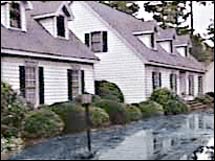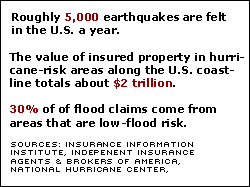
NEW YORK (CNN/Money) -
Natural disasters, like hurricanes and earthquakes, can cause almost unimaginable havoc. Certainly, the costs to insurance companies are enormous. But at least those huge payouts help lessen the pain for individual families whose homes and possessions are destroyed.
Consider the case of Victor Ponte, who owned a home in Beltsville, Md., that was ripped apart by a tornado in September 2001. The massive storm tore aluminum siding from house, destroyed part of his deck and a shed, broke windows, and scattered large branches from his old oak trees.
Except for his $250 deductible, his homeowner's insurance completely covered the $40,000 damage. "Everything was fixed and everyone was paid within three days," said Ponte.
Start with basic insurance
As Ponte learned first hand, the best defense against natural disasters is a solid insurance policy. But you've got to make sure you've got the right kind. Fires will be covered but be aware that the farther you live from a fire station the higher your insurance costs will be.
The most expansive homeowner's coverage you can buy is a so-called HO-3 policy. A cash-value version, however, will leave you short as it only pays for the depreciated value of your dwelling and possessions. Instead, you want to opt for a replacement-cost policy, which pays the actual cost of rebuilding or replacing your home.
| |
 Related Stories
Related Stories
| |
| | |
| | |
|
Standard policies exclude damage from floods, earthquakes and sewer backups -- and in some cases, windstorms. For those, you need separate coverage.
Be sure that you buy from a company that's got a strong rating from A.M. Best or Standard & Poors. And check with your state insurance commissioner to find out if a company has a good reputation for paying claims quickly. Some of Ponte's neighbors, for example, had insurance coverage but claims have still not been paid, he said.
For more buying tips, click on "What to look for in homeowner's insurance." You can also get a free copy of "Project Map," a disaster-plan kit for individuals and homeowners, by calling the Independent Insurance Agents & Brokers of America (800 261-4422).
If you're a renter, you need insurance, too, to protect your possessions. Happily, renter's insurance is cheap – about $300 a year, according to the Insurance Information Institute.
Once your standard policy is in place, you may need to add to it to cover natural disasters. Here's how:
Flood insurance
Roughly 10 percent of American homes are located in a federally classified flood plain, where homeowners must buy flood coverage to qualify for a federally backed mortgage. But even if you live in a less risky area, you also should consider buying it; 30 percent of all flood claims happen outside the officially designated flood plain.
"It's a relative difference between high risk and moderate risk. Just because you're the good side of the line doesn't mean you don't have to worry about being flooded," said Mark Stevens at the Federal Emergency Management Agency, which runs the flood-insurance program.
FEMA sets flood insurance prices so you won't have to "shop around" for the best deal. However, that doesn't mean some people don't pay more. Prices are higher for those living in flood-prone areas. On average, flood insurance runs $386 a year, but if you live on a beach in an area where the risk is high, premiums could cost as much as $2,000 annually or more.

Standard flood insurance coverage is limited to $250,000 worth of coverage for your home and up to $100,000 for its contents. It also excludes certain items. For example, insurance will replace equipment that's normally housed in a basement, such as sump pumps, a furnace, central air conditioners and so on. But anything that's stored in a basement, such as boxes of your holiday decorations, carpeting, or paneling to be used to convert a basement into a room are not covered.
"Basements will fill up first and if everything in a basement were covered, the premiums would be exorbitant," explained FEMA spokesman Mark Stevens.
Those who want more flood protection than a standard policy offers can buy extra coverage through agents, but it's expensive. For a coastal area home, where risk of flooding is highest, premiums will cost $2,500-to-$4,000 for $100,000 worth of extra coverage on your home. In communities that never flood, extra coverage could be as little as $1,250-to-$3,000 for extra value, according to Independent Insurance Agents & Brokers of America.
To find out more about flood insurance, including agents that sell it in your area, call FEMA at 800 621-3362 or log onto the www.fema.gov.
Earthquake insurance
Earthquakes are another hazard that won't be covered in your homeowner's policy, though you can buy it through most agents. (Note: When you do buy insurance, work with an independent insurance agent who works with more than one company. To find one, go to www.independentagent.com.)
In California, coverage also is sold through California Earthquake Authority, which is privately funded but managed by the state government. Premiums vary depending on where you live. You'll also pay more for the kind of house or dwelling you live in. Wood homes, for example, are cheaper to insure than brick buildings since they withstand earthquakes better.
Homeowners and renters in California can use the CEA online premium calculator, which lets you input data such as your Zip code, as well as the age and type of your house, to get an insurance price quotes. You also can call CEA at (877) 797-4300.
As with any coverage, individuals must pay a deductible before insurance coverage kicks in. But deductibles are generally expressed as a percentage of your home's value instead of as a dollar amount. For example, a policy with a 2 percent deductible means a homeowner would have to spend $2,000 to rebuild a home that's worth $100,000.
Deductibles vary from 2 percent up to 20 percent of a home's replacement value. In some states -- like Nevada, California Utah where risk of earthquakes runs high -- deductible minimums are set at 10 percent to 15 percent of a home's value, said Loretta Waters at Insurance Information Institute.
In Washington State -- where earthquake risk is high -- policy holders must pay a 10 percent deductible and the cost of coverage runs from $1.10 and $3.50 per $1,000 of coverage for a wood-frame house and from $3.75 to $14 for $1,000 worth of coverage for a masonry house.
Sewer, septic and drain backups
Sewer drain backups are not normally covered by standard homeowner's policies, so you be sure to find out if you need extra insurance rider. You should expect to spend about $20-to-$40 a year. Don't assume flood insurance will cover you, either. Many times, homeowners don't take theses precautions and they're caught short.
"A year or so go we had rainstorms in Washington, D.C., and water flowed backwards through drain and sewage pipes," recalled Mike McCartin, an independent agent at McCartin Insurance in College Park, Md. "Most people didn't have coverage."
Windstorm coverage
In most states, homeowners insurance covers tornadoes and hurricanes. But in places that are more prone to major windstorms, insurance companies may charge to cover you against losses.
In some parts of Florida where risk of hurricanes runs high, for example, coverage from windstorms is excluded from regular homeowner's policies and individuals must buy extra insurance, which is regulated by the Florida Windstorm Underwriting Association.
Cost for the windstorm coverage runs about $2,600 annually for a $300,000 home, said Alex Soto, an independent insurance agent in Miami. But in low-risk areas of Florida, extra insurance isn't necessary.
"Insurance is a lot like real estate," notes Soto. "It's all about location, location, location."

|

